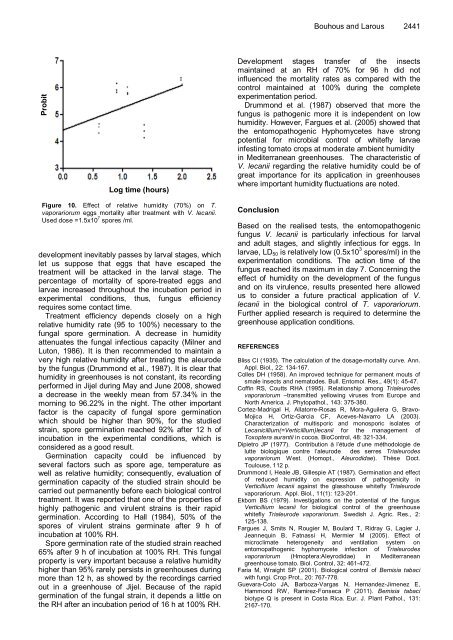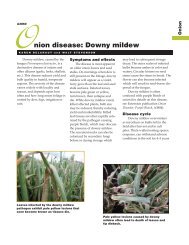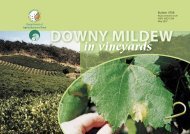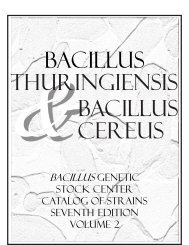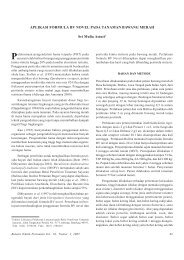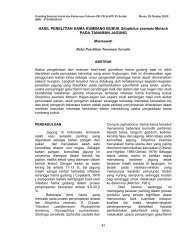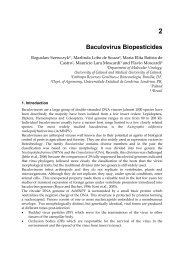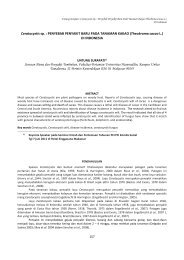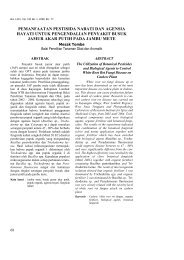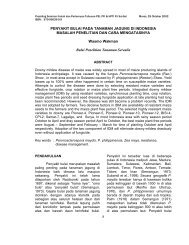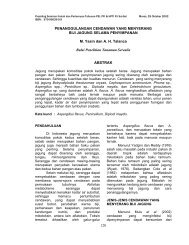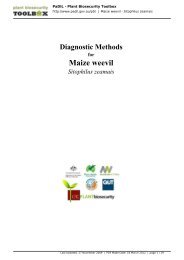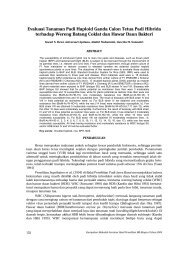Efficiency of the entomopathogenic fungus Verticillium lecanii in the ...
Efficiency of the entomopathogenic fungus Verticillium lecanii in the ...
Efficiency of the entomopathogenic fungus Verticillium lecanii in the ...
Create successful ePaper yourself
Turn your PDF publications into a flip-book with our unique Google optimized e-Paper software.
ProbitBouhous and Larous 2441Log time (hours)Development stages transfer <strong>of</strong> <strong>the</strong> <strong>in</strong>sectsma<strong>in</strong>ta<strong>in</strong>ed at an RH <strong>of</strong> 70% for 96 h did not<strong>in</strong>fluenced <strong>the</strong> mortality rates as compared with <strong>the</strong>control ma<strong>in</strong>ta<strong>in</strong>ed at 100% dur<strong>in</strong>g <strong>the</strong> completeexperimentation period.Drummond et al. (1987) observed that more <strong>the</strong><strong>fungus</strong> is pathogenic more it is <strong>in</strong>dependent on lowhumidity. However, Fargues et al. (2005) showed that<strong>the</strong> <strong>entomopathogenic</strong> Hyphomycetes have strongpotential for microbial control <strong>of</strong> whitefly larvae<strong>in</strong>fest<strong>in</strong>g tomato crops at moderate ambient humidity<strong>in</strong> Mediterranean greenhouses. The characteristic <strong>of</strong>V. <strong>lecanii</strong> regard<strong>in</strong>g <strong>the</strong> relative humidity could be <strong>of</strong>great importance for its application <strong>in</strong> greenhouseswhere important humidity fluctuations are noted.Figure 10. Effect <strong>of</strong> relative humidity (70%) on T.vaporariorum eggs mortality after treatment with V. <strong>lecanii</strong>.Used dose =1.5x10 7 spores /ml.development <strong>in</strong>evitably passes by larval stages, whichlet us suppose that eggs that have escaped <strong>the</strong>treatment will be attacked <strong>in</strong> <strong>the</strong> larval stage. Thepercentage <strong>of</strong> mortality <strong>of</strong> spore-treated eggs andlarvae <strong>in</strong>creased throughout <strong>the</strong> <strong>in</strong>cubation period <strong>in</strong>experimental conditions, thus, <strong>fungus</strong> efficiencyrequires some contact time.Treatment efficiency depends closely on a highrelative humidity rate (95 to 100%) necessary to <strong>the</strong>fungal spore germ<strong>in</strong>ation. A decrease <strong>in</strong> humidityattenuates <strong>the</strong> fungal <strong>in</strong>fectious capacity (Milner andLuton, 1986). It is <strong>the</strong>n recommended to ma<strong>in</strong>ta<strong>in</strong> avery high relative humidity after treat<strong>in</strong>g <strong>the</strong> aleurodeby <strong>the</strong> <strong>fungus</strong> (Drummond et al., 1987). It is clear thathumidity <strong>in</strong> greenhouses is not constant, its record<strong>in</strong>gperformed <strong>in</strong> Jijel dur<strong>in</strong>g May and June 2008, showeda decrease <strong>in</strong> <strong>the</strong> weekly mean from 57.34% <strong>in</strong> <strong>the</strong>morn<strong>in</strong>g to 96.22% <strong>in</strong> <strong>the</strong> night. The o<strong>the</strong>r importantfactor is <strong>the</strong> capacity <strong>of</strong> fungal spore germ<strong>in</strong>ationwhich should be higher than 90%, for <strong>the</strong> studiedstra<strong>in</strong>, spore germ<strong>in</strong>ation reached 92% after 12 h <strong>of</strong><strong>in</strong>cubation <strong>in</strong> <strong>the</strong> experimental conditions, which isconsidered as a good result.Germ<strong>in</strong>ation capacity could be <strong>in</strong>fluenced byseveral factors such as spore age, temperature aswell as relative humidity; consequently, evaluation <strong>of</strong>germ<strong>in</strong>ation capacity <strong>of</strong> <strong>the</strong> studied stra<strong>in</strong> should becarried out permanently before each biological controltreatment. It was reported that one <strong>of</strong> <strong>the</strong> properties <strong>of</strong>highly pathogenic and virulent stra<strong>in</strong>s is <strong>the</strong>ir rapidgerm<strong>in</strong>ation. Accord<strong>in</strong>g to Hall (1984), 50% <strong>of</strong> <strong>the</strong>spores <strong>of</strong> virulent stra<strong>in</strong>s germ<strong>in</strong>ate after 9 h <strong>of</strong><strong>in</strong>cubation at 100% RH.Spore germ<strong>in</strong>ation rate <strong>of</strong> <strong>the</strong> studied stra<strong>in</strong> reached65% after 9 h <strong>of</strong> <strong>in</strong>cubation at 100% RH. This fungalproperty is very important because a relative humidityhigher than 95% rarely persists <strong>in</strong> greenhouses dur<strong>in</strong>gmore than 12 h, as showed by <strong>the</strong> record<strong>in</strong>gs carriedout <strong>in</strong> a greenhouse <strong>of</strong> Jijel. Because <strong>of</strong> <strong>the</strong> rapidgerm<strong>in</strong>ation <strong>of</strong> <strong>the</strong> fungal stra<strong>in</strong>, it depends a little on<strong>the</strong> RH after an <strong>in</strong>cubation period <strong>of</strong> 16 h at 100% RH.ConclusionBased on <strong>the</strong> realised tests, <strong>the</strong> <strong>entomopathogenic</strong><strong>fungus</strong> V. <strong>lecanii</strong> is particularly <strong>in</strong>fectious for larvaland adult stages, and slightly <strong>in</strong>fectious for eggs. Inlarvae, LD 50 is relatively low (0.5x10 3 spores/ml) <strong>in</strong> <strong>the</strong>experimentation conditions. The action time <strong>of</strong> <strong>the</strong><strong>fungus</strong> reached its maximum <strong>in</strong> day 7. Concern<strong>in</strong>g <strong>the</strong>effect <strong>of</strong> humidity on <strong>the</strong> development <strong>of</strong> <strong>the</strong> <strong>fungus</strong>and on its virulence, results presented here allowedus to consider a future practical application <strong>of</strong> V.<strong>lecanii</strong> <strong>in</strong> <strong>the</strong> biological control <strong>of</strong> T. vaporariorum.Fur<strong>the</strong>r applied research is required to determ<strong>in</strong>e <strong>the</strong>greenhouse application conditions.REFERENCESBliss CI (1935). The calculation <strong>of</strong> <strong>the</strong> dosage-mortality curve. Ann.Appl. Biol., 22: 134-167.Colles DH (1958). An improved technique for permanent mouts <strong>of</strong>smale <strong>in</strong>sects and nematodes. Bull. Entomol. Res., 49(1): 45-47.C<strong>of</strong>f<strong>in</strong> RS, Coutts RHA (1995). Relationship among Trialeurodesvaporariorum –transmitted yellow<strong>in</strong>g viruses from Europe andNorth America. J. Phytopathol., 143: 375-380.Cortez-Madrigal H, Allatorre-Rosas R, Mora-Aguilera G, Bravo-Mojica H, Ortiz-Garcia CF, Aceves-Navarro LA (2003).Characterization <strong>of</strong> multisporic and monosporic isolates <strong>of</strong>Lecanicillium(=<strong>Verticillium</strong>)<strong>lecanii</strong> for <strong>the</strong> management <strong>of</strong>Toxoptera aurantii <strong>in</strong> cocoa. BioControl, 48: 321-334.Dipietro JP (1977). Contribution à l’étude d’une méthodologie delutte biologique contre l’aleurode des serres Trialeurodesvaporariorum West. (Homopt., Aleurodidae). Thèse Doct.Toulouse, 112 p.Drummond I, Heale JB, Gillespie AT (1987). Germ<strong>in</strong>ation and effect<strong>of</strong> reduced humidity on expression <strong>of</strong> pathogenicity <strong>in</strong><strong>Verticillium</strong> <strong>lecanii</strong> aga<strong>in</strong>st <strong>the</strong> glasshouse whitefly Trialeurodevaporariorum. Appl. Biol., 11(1): 123-201.Ekbom BS (1979). Investigations on <strong>the</strong> potential <strong>of</strong> <strong>the</strong> <strong>fungus</strong><strong>Verticillium</strong> <strong>lecanii</strong> for biological control <strong>of</strong> <strong>the</strong> greenhousewhitefly Trialeurode vaporariorum. Swedish J. Agric. Res., 2:125-138.Fargues J, Smits N, Rougier M, Boulard T, Ridray G, Lagier J,Jeannequ<strong>in</strong> B, Fatnassi H, Mermier M (2005). Effect <strong>of</strong>microclimate heterogeneity and ventilation system on<strong>entomopathogenic</strong> hyphomycete <strong>in</strong>fection <strong>of</strong> Trialeurodesvaporariorum (Hmoptera:Aleyrodidae) <strong>in</strong> Mediterraneangreenhouse tomato. Biol. Control, 32: 461-472.Faria M, Wraight SP (2001). Biological control <strong>of</strong> Bemisia tabaciwith fungi. Crop Prot., 20: 767-778.Guevara-Coto JA, Barboza-Vargas N, Hernandez-Jimenez E,Hammond RW, Ramirez-Fonseca P (2011). Bemisia tabacibiotype Q is present <strong>in</strong> Costa Rica. Eur. J. Plant Pathol., 131:2167-170.


